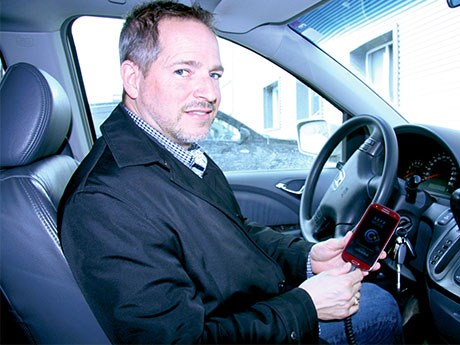Smartphones are great business tool, but a menace in the hands of drivers
Checking a text while driving takes your eye off the road an average of 4.2 seconds, according to Pat Dubreuil of Sudburybased startup Ctrl2Market. During those few blinks of an eye, a driver will travel half the length of a football field, exponentially increasing the risk of a catastrophic event and the liability that goes with it.
Recently proposed legislation in Ontario would, if passed, increase the fine for distracted driving to $1,000 and three demerit points, but Ctrl2Market has an even better solution for fleet operators who want their cell phone addicted employees focused on the road.
CellControl for Fleets, an award-winning distracted driving solution developed by a Baton Rouge, Louisiana-based company, plugs into the ODB2 port underneath the steering wheel of the vehicle and pairs via Bluetooth with the driver’s cell phone.
As soon as the vehicle is in motion, it controls the phone’s usage based on rules pre-set by the system administrator, blocking all texts and most phone calls.
Dubreuil is marketing the CellControl system in partnership with The Installation Group, a Sudbury- based company that had been developing its own distracted driving solution. With some 85 drivers on the road installing Bell satellite dishes in an area stretching from central Ontario all the way to the Manitoba border, Installation Group president Robert Lefebvre knew that fines and demerit points weren’t enough to dissuade cell phone usage.
Dubreuil learned about CellControl while doing a patent search and decided to deploy their technology right away instead of waiting to complete the development of the Installation Group’s solution.
Smart phones
Lefebvre’s need was especially acute because the company provided smartphones are used to transmit work orders and document installations.
“What was happening was the guys were completing their jobs while driving,” said Dubreuil. “It was a huge risk and a potential liability for the company, so this technology made a lot of sense to him to mitigate his liability.”
Drivers are equipped with Bluetooth earpieces, so they can all use their phone to talk, but with two hands on the wheel.
The Installation Group system is set up to allow phone calls from supervisory staff at head office while a vehicle is in motion.
“They’re the only one,” said Dubreuil. “Everyone else gets voice mail, and anyone who texts the technician receives an automatic text response – ‘I’m driving. I’ll get back to you later.’”
Figuring they weren’t the only ones in Northern Ontario with an interest in a distracted driving solution, Dubreuil and Lefebvre struck a deal with CellControl to resell the technology in Canada. Mining suppliers and contractors are an ideal market given mining company policies banning cell phone usage by drivers on their property, according to Dubreuil.
Drivers can talk and text when their vehicle is in Park, but to prevent them from attempting to use their phone while in Park and stopped at a red light, the administrator is able to set a two minute delay before the phone is cleared for use.
If a driver begins a phone call with anyone other than his supervisor while the vehicle is in Park and then drives off, the call is immediately cut off.
Lefebvre also uses CellControl to set a maximum speed of 120 kilometres per hour for the vehicles in his fleet.
Speed control
If a driver breaches the 120 kilometre per hour limit, the administrator receives notification of the infraction via email, allowing him to follow up with the driver. Lefebvre is also able to track idling and monitor gas consumption, a huge expense for the company.
“In January, 80 per cent of the fleet recorded an average of 1.5 hours a day of idle time, but two vehicles racked up six hours a day. Why?” asked Dubreuil. “It turned out that their heaters were broken. We wouldn’t have known without CellControl.”
So, in addition to keeping his drivers from being distracted, Lefebvre is able to use CellControl to manage his costs.
He can monitor personal use of the company cell phones and vehicles, as well as gas consumption. Complementing CellControl are several internally developed apps designed for business process management and cost oversight. Pressing a “gas up” button on a driver’s cell phone, for example, puts it in airplane mode, prompting the driver to take photos of the gas pump display and the vehicle’s odometer reading.
The photos are automatically uploaded to head office and reconciled with monthly statements.
The smartphones also prompt installers to take a specific set of photographs of an installation, which can be reviewed by supervisors at head office in real time for quality control purposes.
“Bell doesn’t require photos, but I do it because my territory is unique,” said Lefebvre. “I have a technician every two hours apart. Other installation companies with five technicians within a 10- kilometre radius can rely on a supervisor to inspect the work. I can’t.”
If a technician is new and there’s some question about the quality of the installation, a supervisor can review the photos and have any deficiencies addressed before the technician leaves for the next job. That saves Lefebvre from having to send an installer back to fix a problem.
When the job is completed, the installer takes a photo of the work order with the customer’s signature for immediate transmission to Sudbury, eliminating the need to fax or mail it.
Another internally developed application called CloudLocate.me leverages the GPS functionality of the company smartphones to keep track of the installers and graphically displays their location on a desktop interface.
The combination of CellControl and The Installation Group’s internally developed apps offers a powerful set of tools for reducing the risk of distracted driving while also managing a dispersed and mobile workforce, claims Dubreuil.



